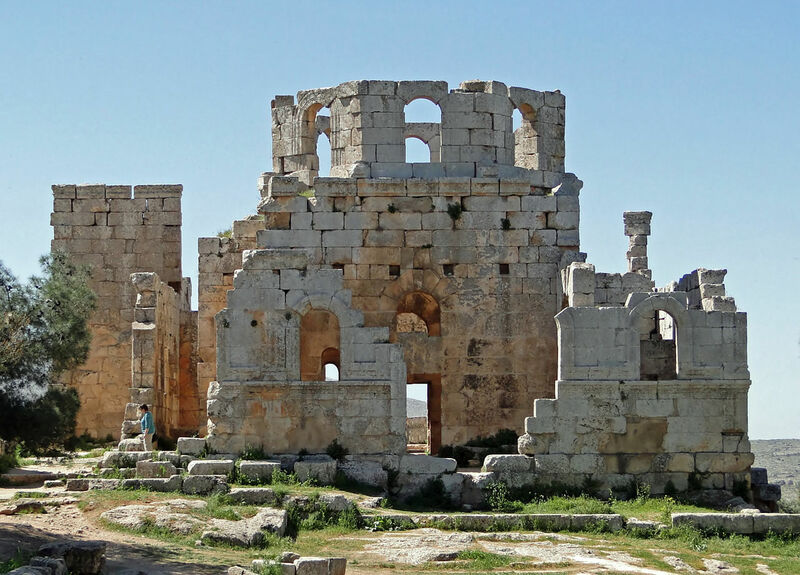Qal'at Sem'an
Type:
Baptisteries,
Capitals,
Churches,
Columns,
Forts and fortresses,
Monasteries,
Pilgrim souvenirs,
Religious complexes,
Shrines,
Tokens,
Votives
Date:
late fifth century (basilicas),
sixth century (monastic buildings),
sixth to seventh century (tokens),
late sixth century (silver votive plaque),
late tenth century (fortress, lead pendants)
Location or Findspot (Modern-Day Country):
Syria
Medium:
Baked clay,
Silver
Description:
Qal'at Sem'an is the monastery and pilgrimage complex built around the column of an ascetic named Symeon the Stylite (ca. 390–459) in the late fifth century. For some forty years, the saintly Symeon had sat atop a tall column (Greek stylos) to remove himself from earthly distractions and get closer to God. When he died, he was buried in Aleppo, 30 kilometers away, but his seventeen-meter-high column remained a potent relic. Symeon's fame was secure; his feast day on September 1 was the start of the Byzantine liturgical year. He had occasional imitators, stylites who sat on columns around the eastern Mediterranean and later in Slavic lands; the practice never caught on in Christian Europe.
No documents attest to the patronage of Qal'at Sem'an, but its high-quality ashlar masonry, with detailed moldings and innovative capitals carved to resemble windblown acanthus leaves, suggests an elite donor, perhaps the Byzantine emperor Zeno (r. 474–91). A monumental triple arch—the form of a Roman triumphal arch—gave access to the walled site. An octagonal baptistery within a rectangular ambulatory was located on the right, flanked by hostels to house pilgrims. Farther inside the enclosure, the saint's column was at the center of four radiating basilicas forming a cross-shaped martyrium (Symeon was considered a bloodless martyr). The column-relic at the center was sheltered by an octagonal wooden roof that probably collapsed in a sixth-century earthquake. Only the eastern basilica is outfitted for the Eucharist, with an apse and side chapels; the others were used for activities related to the saint's cult. Monastic buildings were erected southeast of the martyrium in the sixth century, when Qal'at Sem'an was still one of the major pilgrimage destinations in the eastern Mediterranean region. Men could circumambulate the column and attend mass, but women were restricted to the baptistery and hostels.
Pious visitors took away mementoes of their visit in the form of earthen tokens sanctified by proximity to Symeon's column. These tokens were used for protection or to effect cures. Some pilgrims also left votive objects at the shrine, such as the silver panel with an image of Symeon on his column wrapped by a large snake. The Greek inscription on the bottom says, "In thanks to God and St. Symeon I have offered [this].”
Islamic armies conquered Syria in the seventh century; when the Byzantines reconquered the area briefly in the late tenth century, Qal'at Sem'an became a fortress with the cruciform martyrium as its citadel. Tokens were once again produced, but in the form of lead pendants made in molds that lacked the innate power of the earlier ones made from sanctified earth.
Relevant Primary Sources
No documents attest to the patronage of Qal'at Sem'an, but its high-quality ashlar masonry, with detailed moldings and innovative capitals carved to resemble windblown acanthus leaves, suggests an elite donor, perhaps the Byzantine emperor Zeno (r. 474–91). A monumental triple arch—the form of a Roman triumphal arch—gave access to the walled site. An octagonal baptistery within a rectangular ambulatory was located on the right, flanked by hostels to house pilgrims. Farther inside the enclosure, the saint's column was at the center of four radiating basilicas forming a cross-shaped martyrium (Symeon was considered a bloodless martyr). The column-relic at the center was sheltered by an octagonal wooden roof that probably collapsed in a sixth-century earthquake. Only the eastern basilica is outfitted for the Eucharist, with an apse and side chapels; the others were used for activities related to the saint's cult. Monastic buildings were erected southeast of the martyrium in the sixth century, when Qal'at Sem'an was still one of the major pilgrimage destinations in the eastern Mediterranean region. Men could circumambulate the column and attend mass, but women were restricted to the baptistery and hostels.
Pious visitors took away mementoes of their visit in the form of earthen tokens sanctified by proximity to Symeon's column. These tokens were used for protection or to effect cures. Some pilgrims also left votive objects at the shrine, such as the silver panel with an image of Symeon on his column wrapped by a large snake. The Greek inscription on the bottom says, "In thanks to God and St. Symeon I have offered [this].”
Islamic armies conquered Syria in the seventh century; when the Byzantines reconquered the area briefly in the late tenth century, Qal'at Sem'an became a fortress with the cruciform martyrium as its citadel. Tokens were once again produced, but in the form of lead pendants made in molds that lacked the innate power of the earlier ones made from sanctified earth.
Relevant Primary Sources
Relevant Textbook Chapter(s):
2,
3,
6
Repository and Online Resources:
• Read more about the silver votive plaque on the Musée du Louvre website.
• See another Symeon token from the Walters Art Museum here.
• See additional images of the silver votive plaque on the kornbluthphoto website.
Image Credits:
Wikimedia Commons; Navid Jamali; Dumbarton Oaks, Trustees for Harvard University, Washington, DC; Walters Art Museum; Vatican Library, https://digi.vatlib.it












